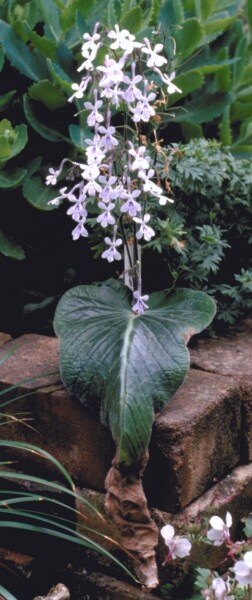Streptocarpus haygarthii is one of many single-leaved, or unifoliate, Streptocarpus species. These plants will often grow for several years, with portions of the leaf dying back annually in response to drought or other seasonal conditions. The portion dying back is called the “abscission zone” and the line marking the boundary between living and dead tissue is called the “abscission line”. In the photo above, the abscission zone is clearly evident, having developed even under greenhouse conditions. It may have been triggered by the short days of its location in Bristol, England, and perhaps by cool nights in a minimally heated greenhouse.
Most unifoliate species are “monocarpic”. While they will often live for several years, they usually die after flowering and fruiting.
Single-leaf species, like S. haygarthii, often grow on vertical surfaces with the leaf hanging straight down. The unifoliate form is particularly well-adapted to such a position, as a taller plant with leaves sticking out would tend to pull out of the very shallow medium (mainly moss) within which the plant is rooted. Colonies can efficiently cover almost the entire surface of such a rock or tree.
S. haygarthii has considerable floral variation across its range, with various degrees of flower color and markings.
Additional photos may be seen in a slideshow by clicking one of the links below:

